Click on images to enlarge
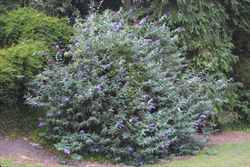
habit (Photo: Trevor James)
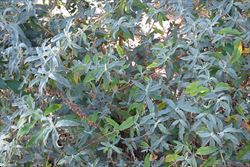
habit in fruit (Photo: Sheldon Navie)
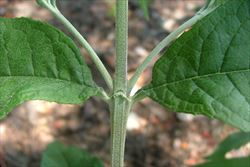
four-sided, hairy, younger stems and leaf bases (Photo: Sheldon Navie)

leaf (Photo: Sheldon Navie)

leaf undersides (Photo: Trevor James)

dense, elongated, flower cluster (Photo: Sheldon Navie)
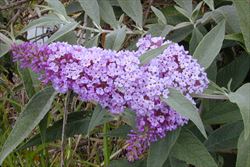
branched flower cluster (Photo: Forest and Kim Starr, USGS)

close-up of flowers (Photo: Sheldon Navie)
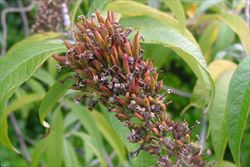
immature fruit (Photo: Sheldon Navie)
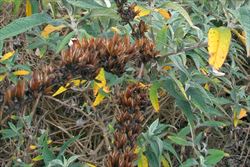
mature fruit (Photo: Forest and Kim Starr, USGS)
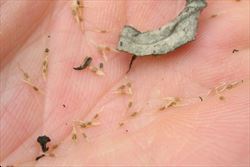
close-up of winged seeds (Photo: Forest and Kim Starr, USGS)
Scientific Name
Buddleja davidii Franch.
Synonyms
Buddleja variabilis Hemsley
Family
Buddlejaceae
Common Names
buddleia, buddleja, butterfly bush, butterfly-bush, orange eye, orange eye butterflybush, orange-eye butterfly-bush, orange-eye butterflybush, purple buddleia, summer lilac
Origin
Native to eastern Asia (i.e. western and central China).
Cultivation
Widely cultivated as a garden ornamental, particularly in the temperate and sub-tropical regions of southern and eastern Australia. A wide variety of ornamental cultivars, with flower colours ranging from deep purple to white, have been developed.
Naturalised Distribution
Widely naturalised in south-eastern Australia (i.e. in some parts of eastern New South Wales, in many parts of Victoria, in Tasmania and in south-eastern and southern South Australia). Possibly also naturalised in the cooler parts of south-eastern Queensland.
Naturalised overseas in Europe, Malaysia, New Zealand, Hawaii and parts of eastern and western USA.
Habitat
A weed of disturbed sites, waste areas, roadsides, drainage lines, creek-banks, riparian areas, dry river beds, open woodlands and forestry plantations in temperate and cooler sub-tropical regions.
Habit
An upright (i.e. erect) shrub usually growing 1-3 m tall, but occasionally reaching up to 5 m in height. It may lose some of its leaves during winter (i.e. it is semi-deciduous).
Distinguishing Features
-
an upright shrub with arching stems usually growing 1-3 m tall.
- the oppositely arranged leaves (4-20 cm long and 1-8 cm wide) are elongated in shape with finely toothed margins.
-
these leaves have dark green hairless upper surfaces and greyish-green velvety hairy undersides.
-
its small tubular flowers (8-14 mm long) are borne in dense clusters (12-30 cm long) at or near the tips of the branches.
-
these flower are mauve or purple (occasionally white to dark purple) with orange-yellow mouths.
-
its fruit is an elongated capsule (5-10 mm long) with two compartments.
Stems and Leaves
The arching stems are densely covered with whitish or greyish hairs (i.e. tomentose) and are bluntly four-angled (i.e. quadrangular) when young. They become almost hairless (i.e. glabrescent) and rounded as they mature.
The oppositely arranged leaves are elongated (i.e. narrowly-ovate) to somewhat egg-shaped in outline (i.e. oblong-ovate) and are borne on short stalks (i.e. petioles) 1-5 mm long. These leaves (4-20 cm long and 1-8 cm wide) have toothed (i.e. crenate to crenulate) margins and pointed tips (i.e. acute or acuminate apices). The upper surface of the leaves is dark green and mostly hairless (i.e. glabrous), while the lower surface is covered in velvety whitish hairs (i.e. tomentose) and is greyish-green in colour.
Flowers and Fruit
The small tubular flowers (8-14 mm long and about 5 mm across) are borne in un-branched or branched elongated clusters (i.e. racemes or thyrsoid cymes) 12-30 cm long and 2-5 cm wide, that are formed at or near the tips of the branches (i.e. they are terminal and/or axillary). Each flower has four mauve or purple (occasionally white to dark purple) petals that are fused together into a tube (i.e. corolla tube) for most of their length (i.e. tube 6-11 mm long). The four spreading petal lobes (i.e. corolla lobes) are 1.5-3 mm long and the mouth of the tube is usually orange-yellow in colour. The flowers also have four small green sepals (2-3.5 mm long) that are also fused together (i.e. into a calyx tube) for half of their length. Each flower also has four stamens and an ovary topped with a style (0.5-1.5 mm long) and a club-shaped (i.e. clavate) stigma. These sweetly scented flowers are either stalkless (i.e. sessile) or shortly stalked (i.e. sub-sessile). Flowering occurs mostly during spring and summer (i.e. from November to February).
The fruit is an elongated (i.e. narrowly-ellipsoid or narrowly-ovoid) capsule with two compartments containing numerous seeds. These capsules (5-10 mm long and 1.5-2 mm wide) turn from green to brownish in colour as they mature. Fruit are present from later summer to early winter (i.e. from February to June). The seeds (2-4 mm long and about 0.5 mm wide) are oval in shape (i.e. ellipsoid) with wings at both ends.
Reproduction and Dispersal
This species reproduces mainly by seed. These seeds are spread by water, wind, vehicles, animals and in dumped garden waste.
Environmental Impact
Butterfly bush (Buddleja davidii) is regarded as a significant environmental weed in Victoria and as an environmental weed in Tasmania and New South Wales. It is becoming widespread and common in Victoria and Tasmania, and in New South Wales it is mainly restricted to the cooler tableland regions and the southern and central coastal districts. This plant has not yet reached its full potential as an invasive species in Australia, and it represents a threat to many vegetation communities including damp sclerophyll forests and riparian areas. Dense infestations compete with indigenous vegetation and impede the growth and reproduction of other species of trees and shrubs.
Butterfly bush (Buddleja davidii) is also very invasive in New Zealand, where infestations as dense as 2500 plants per hectare have been recorded. It is of particular concern in Urewara National Park, on the North Island of New Zealand, where it has spread deep into this important conservation area. It is also listed in the Global Invasive Species Database.
Other Impacts
The flowers and fruit of butterfly bush (Buddleja davidii) are potentially poisonous to humans. Dense monospecific stands of this species can also impede access to rivers and its shallow root system can result in the erosion of stream banks during floods.
Legislation
Not declared or considered noxious by any state government authorities.
Similar Species
Butterfly bush (Buddleja davidii) is similar to several other buddleias (Buddleja spp.) that have also recently become naturalised in Australia. These include climbing white sage (Buddleja dysophylla), orange ball tree (Buddleja globosa), Lindley's butterfly bush (Buddleja lindleyana) and orange buddleia (Buddleja madagascariensis). These species cn be distinguished by the following differences:
- butterfly bush (Buddleja davidii) is an upright or arching shrub with elongated (i.e. narrowly ovate) leaves 4-20 cm long. Its mauve or purple (occasionally white) flowers have a orange-yellow throat and are borne in dense elongated clusters 12-30 cm long. Its fruit is a narrow brown capsule (5-10 mm long) that splits open when mature.
- climbing white sage (Buddleja dysophylla) is a sprawling or climbing shrub with triangular or heart-shaped (i.e. cordate) leaves 1-10 cm long. Its white or greenish-yellow flowers have a reddish-maroon throat and are borne in elongated clusters up to 30 cm long. Its fruit is a very small capsule (2-3.5 mm long) that splits open when mature.
- orange ball tree (Buddleja globosa) is an upright or arching shrub with elongated (i.e. narrowly ovate) leaves up to 20 cm long. Its yellow or orange flowers are borne in small rounded clusters about 2 cm across. Its fruit is a capsule that splits open when mature.
- Lindley's butterfly bush (Buddleja lindleyana) is an upright or arching shrub with elongated (i.e. narrowly ovate) leaves 3-11 long. Its purple flowers are borne in relatively loose elongated clusters 4-20 cm long. Its fruit is a short oval capsule (4-6 mm long) that splits open when mature.
- orange buddleia (Buddleja madagascariensis) is a straggling or climbing shrub with elongated (i.e. narrowly ovate) leaves 2-15 cm long. Its orange or yellow flowers are borne in dense elongated up to 25 cm long. Unlike the other species, its fruit is a globular blue or black berry (2.5-5 mm across).

